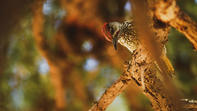No Headaches
Woodpeckers are remarkable for their ability to chisel into bark and wood in search of insect larvae or to create their hole-cavity nests during the breeding season.

Despite the shock involved in making headway through bark and into solid wood, woodpeckers do not suffer from concussion and are in fact precisely equipped to deal with their lifestyles.
Woodpeckers have long, straight powerful beaks for chiselling and drilling into wood. Due to the wear and tear involved, the beak grows continuously to replace keratin that flakes away. The base of the bill is broad and acts as a shock absorber. The neck muscles of a woodpecker are well developed to power the drilling strokes of the neck and head.
The skull of a woodpecker is sturdy to absorb the blows of hammering wood. There is a special hinge between the nasal and frontal bones of the skull that dissipates the shock and the delicate brain is cushioned within the skull so as to counter these effects as well.
Incredibly Long Tongues
Woodpeckers have exceptionally long tongues. The tongue muscle starts behind the eye and stretches over the skull of the bird before entering its mouth cavity. This may help with insulating the skull against shock.
The tongue is able to extend well beyond the end of the bill to probe for buried insect larvae under the bark. A sticky salivary covering ensures that prey sticks to the woodpecker's tongue before it is drawn back into the mouth. The Bennett’s woodpecker which spends much time foraging for termites on the ground has particularly glue-like saliva. Woodpeckers also have barbs on their tongues to facilitate the capture of their prey.
Woodpeckers have reinforced retrices (tail feathers) the shafts of which are thicker and more rigid than in other birds and are used to help prop the birds vertically up against the trunk of a tree while they forage in the manner of a tripod.
Two Front and Two Back
Woodpeckers have zygodactylous feet with two toes facing forward and two backwards. This foot structure is a modification to clinging in the way a woodpecker must against bark. Having the additional support of two toes facing backwards instead of one (like perching birds) makes them agile climbers.
Woodpeckers are one of only a few families of birds that are able to make their own holes in trees for nesting. Although many bird species nest in natural cavities in trees, few are actually able to drill out the adequately large nesting holes that woodpeckers do.
Usually, they use dead trees for this purpose and the circular entrance is only ever wide enough for the adult to squeeze through omitting the possibility of larger predators gaining entrance. Remarkably, woodpeckers make new nests every year. The old ones are then taken over by other hole-nesting birds like starlings.
Energy Saving
Woodpeckers save energy when flying by using a bounding flight pattern that is characteristic and makes the family easy to recognize in flight. Between bouts of flapping (which help the bird gain lift and momentum), woodpeckers close their wings and ‘free-wheel’ a short distance descending slightly as they ‘fall’. Another bout of flapping then ensues and the pattern is repeated until the bird reaches its destination.
Woodpeckers use a unique form of communication. Apart from having individual species calls, they also employ a technique called drumming. The bearded woodpecker is especially adept at drumming and choosing a log with good resonance will thump out a rhythm with his sturdy bill to advertise territory or attract a mate. Individual birds can even be identified through their drumming signatures. Drumming is much louder and better coordinated than the noises made when woodpeckers forage.
Holes on the surface of trees are typically left behind after woodpeckers have been foraging there.
By Megan Emmet